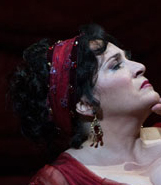Key Word Search
Multi-Field Search
Browse
Repertory Report
Performers Report
Contacts
Met Opera Website
Tosca
Metropolitan Opera House, Tue, October 29, 2013
Broadcast
Tosca (926)
Giacomo Puccini | Luigi Illica/Giuseppe Giacosa
- Tosca
- Patricia Racette
- Cavaradossi
- Roberto Alagna
- Scarpia
- George Gagnidze
- Sacristan
- John Del Carlo
- Spoletta
- Eduardo Valdes
- Angelotti
- Donovan Singletary
- Sciarrone
- James Courtney
- Shepherd
- Seth Ewing-Crystal
- Jailer
- Ryan Speedo Green
- Conductor
- Riccardo Frizza
- Production
- Luc Bondy
- Set Designer
- Richard Peduzzi
- Costume Designer
- Milena Canonero
- Stage Director
- Paula Williams
Performance dedicated to the memory of Tito Gobbi on the centennial of his birth.
He appeared as Scarpia 28 times with the Metropolitan Opera between 1956 and 1975.
Broadcast live on Metropolitan Opera Radio Sirius XM channel 74
Streamed at metopera.org
A co-production of the Metropolitan Opera, Bayerische Staatsoper and Teatro alla Scala
Production photos for Tosca by Marty Sohl/Metropolitan Opera
Tosca received twelve performances this season.
Review 1:
Wilborn Hampton in The Huffington Post
The New “Tosca” is Back Onstage And It’s Still Shocking
The Metropolitan Opera returned its controversial production of Puccini's “Tosca” to the stage last night with Patricia Racette in the title role and Roberto Alagna singing her artist lover, Cavaradossi. Whatever else one may say about Luc Bondy's staging, and opera buffs have said a lot since its premiere four years ago, it is still a shocker.
The Bondy version of Puccini's popular opera opened the Met season in 2009 and became an immediate touchstone of Peter Gelb's stewardship as the company's general manager. The production was excoriated by critics as a travesty and lauded by supporters as visionary. There was and still is no middle ground.
Opera fans around the world will get a chance to decide for themselves which side they're on when the Met simulcasts a performance on Nov. 9 as part of its Live in HD series to some 1,900 theaters in 64 countries.
It probably did not help endear the Bondy staging to the hearts of Met audiences that it replaced a 1985 production by Franco Zeffirelli that was one of the most beloved in the repertory, one whose sets re-created in rich detail three of Rome's familiar tourist destinations.
The contrasts begin as soon as the curtain rises. During the overture the audience finds itself in what more resembles a vaulted catacomb than the magnificent 17th-century Baroque church of SantAndrea della Valle. And the painting that Cavaradossi is executing looks more like a model for a modem-day perfume ad, complete with one breast bared. It is certainly not a depiction of Mary Magdalene that would find a place in any church in Christendom.
The second act provides a further jolt. Instead of the 16th-century Renaissance splendor of the Famese Palace, the audience finds itself in what would appear to be the basement of a brothel. Hookers lounge on sofas waiting to service Scarpia while the police chief struts around like Tony Soprano at the Bada Bing. At least the business of simulated fellatio in the 2009 performances has been excised.
But a bigger concern in the Bondy production than the unconventional sets are some of the stage directions that change the very nature of Puccini's characters. To give a couple of Act 1 examples: Tosca slashes the painting of Mary Magdalene that Cavaradossi is working on, destroying it. And at the end of the act, Scarpia throws his arms around a statue of the Madonna in a lustful, sacrilegious embrace rather than kneel before it in prayer.
When a director takes such liberties in the theater or the movies, it usually means he doesn't trust the original material. One has the feeling watching Bondy's “Tosca” that he either doesn't particularly like Puccini's opera or doesn't think it can stand on its own without some sexy spicing up.
The Met is offering a dozen performances of Tosca this season with Racette splitting the title role with Sondra Radvanovsky and Elisabete Matos and Alagna sharing the tenor's part with Marcello Giordani and Ricardo Tamura. George Gagnidze sings Scarpia in all of them.
Racette brings plenty of jealous passion to the part of Tosca. Her voice is expressive but thin in some passages and occasionally has difficulty carrying over the pit. Her "Vissi d'arte" was acceptable but not exactly moving and she and Riccardo Frizza, who conducted, were not always together.
Alagna makes a dashing Cavaradossi. His solid tenor is a pleasure, although the very top of the register is a bit of a stretch. His third-act aria "E lucevan le stele" was the high point of the evening. Gagnidze's commanding baritone gave a fearsome malevolence to Scarpia.
Search by season: 2013-14
Search by title: Tosca,
Met careers
- Riccardo Frizza [Conductor]
- Patricia Racette [Tosca]
- Roberto Alagna [Cavaradossi]
- George Gagnidze [Scarpia]
- John Del Carlo [Sacristan]
- Eduardo Valdes [Spoletta]
- Donovan Singletary [Angelotti]
- James Courtney [Sciarrone]
- Seth Ewing-Crystal [Shepherd]
- Ryan Speedo Green [Jailer]
- Luc Bondy [Production]
- Richard Peduzzi [Set Designer]
- Milena Canonero [Costume Designer]
- Paula Williams [Stage Director]
